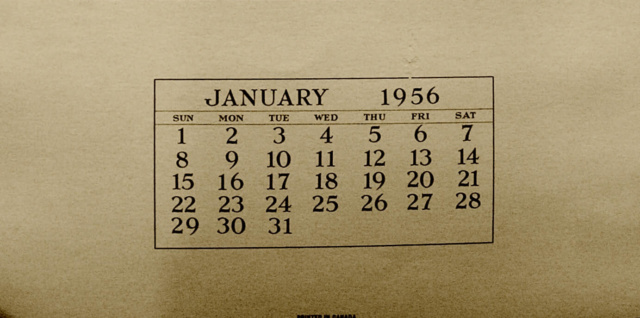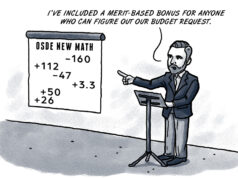
I celebrated New Year’s Eve early this year — and so did you.
It takes the earth 365.25 days to make a complete orbit around the sun, so the true new year actually begins six hours after midnight Jan. 1. That means in four years we would be 24 hours early, a problem solved by adding an extra day and making a leap year.
This solution was introduced Jan. 1, 45 B.C., by Roman Emperor Julius Caesar, in whose honor the calendar with quadrennial leap years is called the Julian calendar. Actually, it only takes the earth 365.2425 days to completely orbit the sun, so the Julian New Year’s Eve comes a little too late (0.0075 days, to be exact), which gradually adds up to being 18 hours late every 100 years.
So, every century a leap year is skipped, but now Jan. 1 is six hours early, so every 400 years the skipped leap year isn’t skipped. Pope Gregory XIII introduced this solution in October 1582, so in his honor this calendar with the skipped leap years is called the Gregorian calendar. We use it today.
Eastern Europe late to the party
Not everyone in 1582 acknowledged papal authority, in particular the various Orthodox churches of Eastern Europe. Even today those churches continue to use the Julian calendar for liturgical purposes. In this century and the previous one, Julian New Year’s Eve comes on Jan. 13 and is celebrated accordingly, even by the secular, in many places in Eastern Europe, for example Russia or Ukraine.
Americans planning to celebrate Julian New Year’s in solidarity with the Ukrainians (or Russians), or simply to use up the leftover champagne, should note that, this year, Jan. 13 is a Friday, and Friday the 13th has its own traditions.
Identify months that begin on Sundays
There will be two months when the 13th comes on a Friday this year: January and October. Last year there was just one (May), which is the minimum possible. But in 2015, there were three (February, March and November), which is the maximum.
Figuring out how many Friday the 13ths will be in a given year is easy. The principle to keep in mind when counting days of the week is that you repeat every seven days, so sevens can be ignored.
For instance, if the first is a Sunday, then the 13th will be a Friday. Since the 13th of the month comes 12 days after the first (13=1+12) and 12=7+5, the day of the week on which the 13th occurs in any given month is always five days after the day of the week on which the first occurs.
So to count Fridays that fall on the 13th, we count months that begin on Sundays. And these are determined by the day of the week on which Jan. 1 occurs, and depends on whether it is a leap year or not.
How to calculate monthly starting days
In any given year, Feb. 1 is 31 days after Jan. 1, and 31=7+7+7+7+3=4×7+3, so February starts three days of the week after the day of the week on which January began.
In an ordinary year like this one, March starts 28 days after Feb. 1, and 28=4×7+0, so March starts on the same day as February.
Then April starts 31 days later (again, 4×7+3), or three days of the week after March and February, which in turn began three days of the week after January’s start day. Thus April starts 3+3=6 days of the week later than Jan. 1.
May 1 comes 30=4×7+2 days after April 1, so two days of the week later, and so 6+2 days of the week after Jan. 1. But 6+2=8=7+1, so in counting days of the week, May 1 is one day of the week after Jan. 1. Working out the rest of the year gives the following list of first-of-the-month days after Jan. 1 (ordinary year):
(0,3,3,6,1,4,6,2,5,0,3,5)
In a leap year, March 1 comes a day later, so we get:
(0,3,4,0,2,5,0,3,6,1,4,6)
If we assume that the numbers 0 through 6 represent days of the week (0=Sunday, 1=Monday, etc.), then adding the numbers in parentheses to the number representing the day of the week for January 1 (and dropping out sevens when they occur) gives the numbers that represent the day of the week on which each month will begin.
Using offsets to calculate Friday the 13th
Here’s how these numbers (which are called offsets) are used: If Jan. 1 is a Friday in a leap year (as it was in 2016), then Oct. 1 is one day of the week later, a Saturday (as it was in 2016), and Nov. 1 is four days of the week later, a Tuesday (as it was in 2016).
Consider the offsets for an ordinary year:
(0,3,3,6,1,4,6,2,5,0,3,5)
The offset 3 is repeated three times, the offsets 6, 5 and 0 are repeated twice, and the offsets 4, 2 and 1 occur only once.
Remember that the 13th always occurs on a Friday if the month starts on a Sunday. Sunday is three days after Thursday, so if an ordinary year starts on Thursday then there are three months that start on Sunday and three Friday the 13ths (February, March and November).
Sunday is six days after Monday, five days after Tuesday and zero days after Sunday, so if an ordinary year starts on a Monday, Tuesday or Sunday then there are two months that begin on Sunday and so two Friday the 13ths.
If Jan. 1 is any of the other three days (Wednesday, Friday or Saturday) only one month starts on a Sunday, so there will be only one Friday the 13th.
In a leap year there is one triple offset (0), three double offsets (6,4,3), and three single offsets (5,2,1). So if Jan. 1 of a leap year is a Sunday, there are three Friday the 13ths, if it’s a Monday, Wednesday or Thursday there are two, and if it’s a Tuesday, Friday, or Saturday, there’s only one.
In the interest of illuminating our more visual-based learning readers, take a look at this tabular representation of the above explanation:
| IN NORMAL YEARS | IN LEAP YEARS | ||
| Jan. 1 falls on: | # of Friday the 13ths | Jan. 1 falls on: | # of Friday the 13ths |
| Sunday | 2 | Sunday | 3 |
| Monday | 2 | Monday | 2 |
| Tuesday | 2 | Tuesday | 1 |
| Wednesday | 1 | Wednesday | 2 |
| Thursday | 3 | Thursday | 2 |
| Friday | 1 | Friday | 1 |
| Saturday | 1 | Saturday | 1 |
Readers who are reluctant to push their luck celebrating Julian New Year’s Eve on Friday the 13th don’t need to wait until 2018, however: the Eve of the Chinese New Year comes up Jan. 27.





















